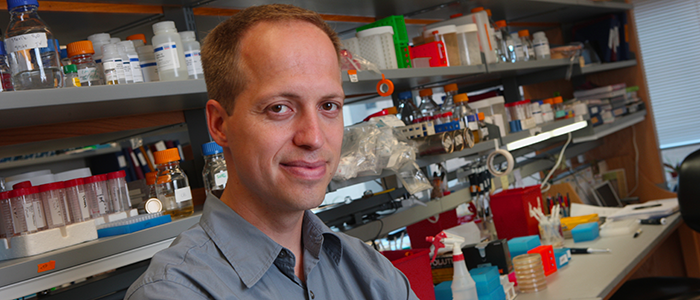Natural genetic variation in a protective antiviral enzyme holds promise for new therapies.

Doctors have long been mystified as to why HIV-1 rapidly sickens some individuals, while in others the virus has difficulties gaining a foothold. Now, a study of genetic variation in HIV-1 and in the cells it infects reported, by University of Minnesota researchers in this week’s issue of PLOS Genetics, has uncovered a chink in HIV-1’s armor that may, at least in part, explain the puzzling difference — and potentially open the door to new treatments.
HIV-1 harms people by invading immune system cells known as T lymphocytes, hijacking their molecular machinery to make more of themselves, then destroying the host cells — leaving the infected person more susceptible to other deadly diseases. T lymphocytes are not complete sitting ducks, however. Among their anti-virus defense mechanisms is a class of proteins known as APOBEC3s that have the ability to block the HIV-1’s ability to replicate. However, HIV-1 has a counter-defense mechanism — a protein called Vif that cons the T lymphocytes into destroying their own APOBEC3.
Suspecting differential susceptibility to HIV-1 might be related to genetic variations in this system, a research team led by Professor Reuben Harris of the University’s College of Biological Sciences and Medical School and doctoral student Eric Refsland, took a closer look. First, the researchers found that HIV-1 infection boosts the production of one kind of APOBEC3, APOBEC3H — suggesting it’s a key player in fighting back. Then, using an experimental technique known as separation of function mutagenesis, they discovered that different people have different strengths/potencies of APOBEC3H, with some proteins expressed stably and others inherently unstable. The stable variations, the researchers found, were able to successfully limit HIV-1’s ability to replicate if the infecting virus had a weak version of Vif — but not for HIV-1 viruses that had strong Vif.
“This work shows that the competition between the virus and the host is still ongoing,” Refsland says. “The virus hasn’t completely perfected its ability to replicate in humans.”
Armed with this clearer picture of the multifaceted interactions between Vif and APOBEC3, Harris says. The next step is to figure out how to stop Vif from disabling the APOBEC3 enzymes. “One could imagine drugs that stop Vif from binding with APOBEC,” he said. “This is a bonafide HIV killing pathway, and we just have to devise clever ways to activate it in infected persons. Such an approach could indefinitely suppress virus replication, and even result in curing it.”
– Mary Hoff